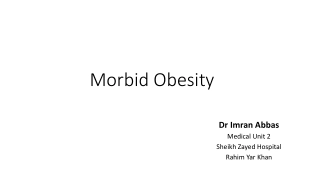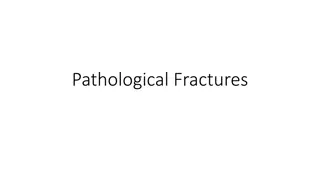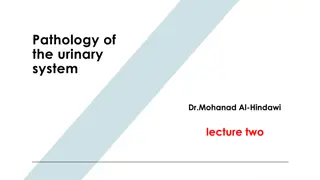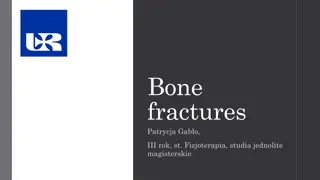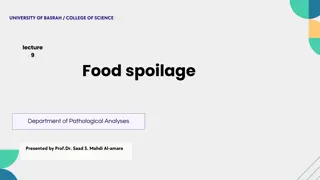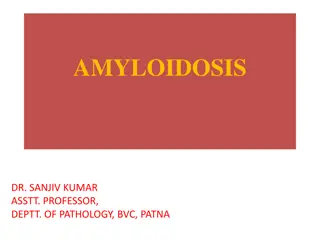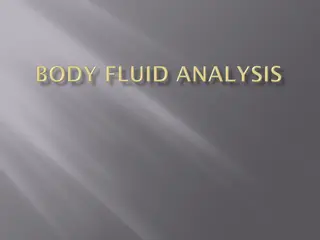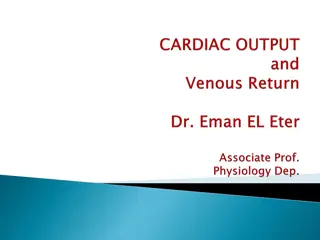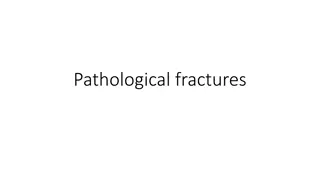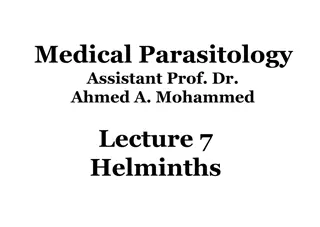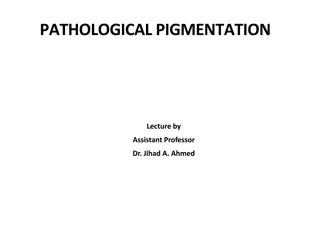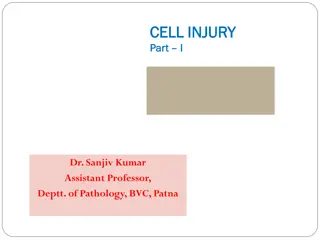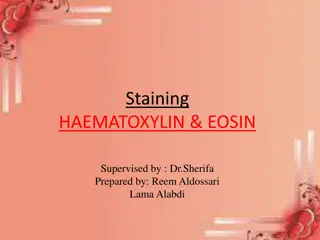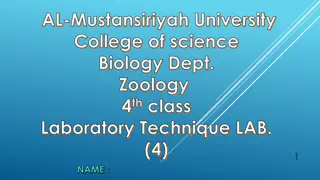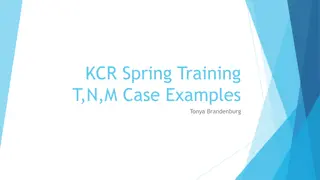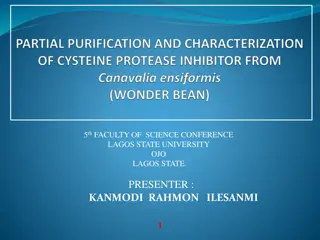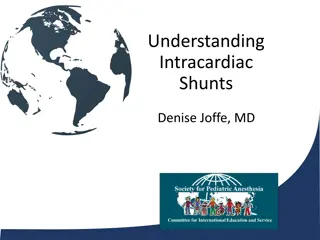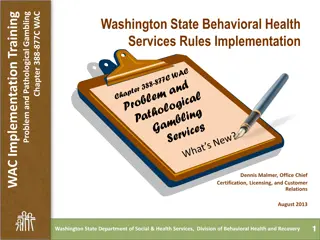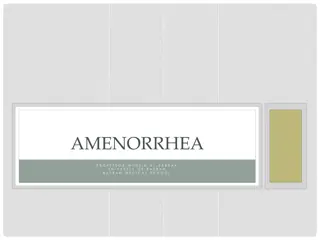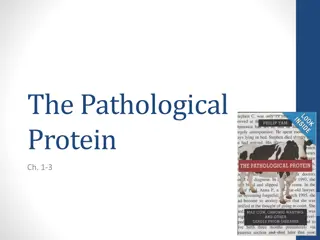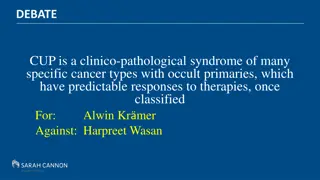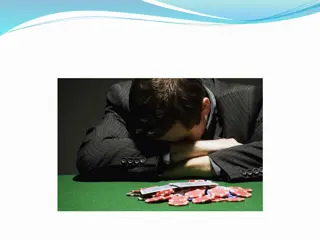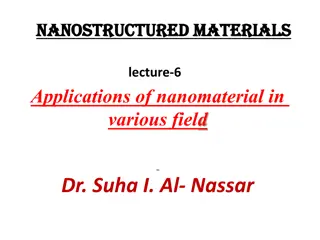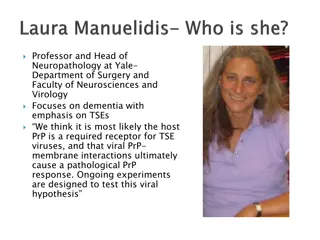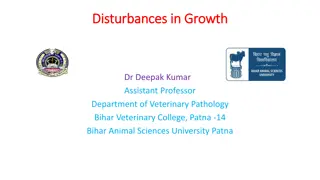Morbid Obesity
Morbid obesity, its definition, BMI, and the pathological consequences it has on health. Dr. Imran Abbas's medical unit at Sheikh Zayed Hospital in Rahim Yar Khan specializes in treating morbid obesity and related health conditions.
0 views • 24 slides
Pathology Acute kidney injury
Guidelines of renal biopsy, types of acute kidney injury, clinical manifestations, and pathological findings in this comprehensive lecture. Explore the normal anatomy and histology of the kidney, terminology, etiology, pathophysiology, and more.
8 views • 17 slides
Pathological Fractures
Pathological fractures occur in weakened bones due to underlying diseases or conditions, often manifesting with minimal trauma. Common causes include neoplastic lesions, infections, metabolic imbalances, and developmental disorders. Recognizing these fractures is crucial for timely intervention and
1 views • 20 slides
Pathology of the urinary system
Focal segmental glomerulosclerosis (FSGS) is characterized by sclerosis of some glomeruli, while membranous nephropathy (MN) involves subepithelial immunoglobulin deposits. FSGS can lead to end-stage renal disease, with poor response to corticosteroid therapy. MN, on the other hand, shows diffuse ca
1 views • 20 slides
Cellular Pathology: Response to Stress and Disease Predisposition
Explore the hallmarks of cellular pathology, including factors influencing disease predisposition such as genetics, environmental factors, and lifestyle. Delve into the cellular response to stress, adaptive and pathological reactions, and key stressors disrupting cellular homeostasis. Uncover how ce
0 views • 51 slides
Radiographic Imaging Methods of the Respiratory System
Radiographic imaging plays a crucial role in the evaluation and diagnosis of thoraco-mediastino-pleuro-pulmonary conditions. Techniques like radioscopy, digital radiography, computer tomography, magnetic resonance imaging, conventional pulmonary angiography, and hybrid imaging methods offer detailed
11 views • 21 slides
Bone Fractures
Bone fractures can occur due to external forces, high-energy trauma, bone fatigue, or underlying skeletal diseases. Symptoms include pain, tenderness, swelling, and difficulty moving. Different types of fractures include nondisplaced, displaced, compound, pathological, longitudinal, and spiral fract
1 views • 15 slides
Food spoilage
In this lecture from the Department of Pathological Analyses at the University of Basrah, Prof. Dr. Saad S. Mahdi Al-amaradi Al-Amara discusses food spoilage, focusing on cereals, bakery foods, and meat products. The presentation covers the microbial spoilage of grains, including common mold species
1 views • 9 slides
Cutaneous Manifestations of Systemic Diseases: Endocrine Disorders and Diabetes Mellitus
Explore the cutaneous manifestations of systemic diseases, particularly focusing on endocrine disorders like diabetes mellitus. Learn about the dermatologic signs associated with conditions such as hypothyroidism, hyperthyroidism, Addison's disease, and Cushing syndrome. Discover specific manifestat
1 views • 88 slides
Amyloidosis: Causes, Types, and Pathological Characteristics
Amyloidosis is a disorder characterized by the deposition of abnormal amyloid fibrils in tissues, impacting various organs. This condition is associated with different types of amyloid, such as AA and AL amyloid. The deposition of amyloid can lead to tissue damage and organ dysfunction. Primary and
1 views • 11 slides
Cerebrospinal Fluid Analysis
Explore the essential aspects of cerebrospinal fluid (CSF) analysis, from routine laboratory assays to interpretation of pathological conditions. Learn about CSF formation, normal parameters, and interpretation of lab results to diagnose various neurological conditions.
1 views • 76 slides
Cardiac Output and Venous Return in Cardiovascular Physiology
Cardiac output, stroke volume, end-diastolic and end-systolic volumes play vital roles in cardiovascular function. Factors affecting cardiac output include physiological conditions and pathological states like hyperthyroidism and myocardial infarction. Venous return, controlled by mechanisms like Fr
0 views • 27 slides
Biohazardous Waste Management
Biohazardous waste poses a threat to living organisms, particularly humans, due to biological hazards like medical waste or toxins. This waste includes categories such as solid, liquid, sharps, and pathological waste, each requiring proper segregation and disposal to minimize health risks. Learn abo
1 views • 15 slides
Fractures: Traumatic vs. Pathological and Modeling Options
Defining the distinction between traumatic and pathological fractures, exploring the relationship between non-traumatic fractures and underlying bone pathologies, and discussing modeling options for classifying fractures. Stress fractures, insufficiency fractures, and the causes of pathological frac
5 views • 8 slides
National Free Diagnostics Initiative Overview
The National Free Diagnostics Initiative aims to provide essential diagnostic services free of cost in public health facilities, leveraging existing institutional structures. The initiative covers a range of pathological and radiological tests at different levels of care, with outsourcing for high-c
2 views • 20 slides
Overview of Ancylostoma duodenale (Hookworm) Infection
Ancylostoma duodenale, a parasitic worm causing Ancylostomiasis, is discussed in this lecture. The infection's distribution, morphology, life cycle, and pathology are detailed, emphasizing the impact on humans. The lifecycle stages, including egg production, larval development, and entry into the hu
0 views • 12 slides
Pathological Pigmentation: Causes and Effects
Pathological pigmentation involves the abnormal deposition of pigments in the body. It can be classified as exogenous or endogenous, with various sources and types of pigments. Melanin, one of the endogenous pigments, plays a crucial role in determining tissue color and can have protective functions
5 views • 23 slides
Cell Injury and Adaptation in Pathology
Rudolph Virchow's concept of disease starting at the cellular level highlights how cells constantly face challenges in maintaining homeostasis. The plasma membrane acts as a barrier against external stressors, but when cells face excessive physiological stresses or pathological stimuli, they adapt o
0 views • 16 slides
H&E Staining in Histology
H&E staining, a widely used histological technique, involves staining cell nuclei blue and cytoplasmic components pink to aid in tissue structure analysis. This method provides essential insights into normal and pathological tissue changes, assisting in diagnoses and further testing decisions. The p
0 views • 7 slides
Common Laboratory Techniques in Zoology - Urine and Stool Specimen Analysis
In the Biology Department at Al-Mustansiriyah University, students learn laboratory techniques for collecting and analyzing urine and stool specimens. The process involves random urine sample collection, urine tests for chemical components, urine culture, stool specimen analysis for pathological con
0 views • 10 slides
Addressing Pathological Conditions in Local Churches
Pathological conditions affecting local churches such as "Ethnic-itis," "Ghost town," and "People blindness" are discussed along with their symptoms and remedies. Solutions include transitioning to reflect the neighborhood, using circuit-riding pastors in rural churches, and celebrating cultural dif
1 views • 20 slides
Pathological Differences in Hip Joint Variations: Abnormal Gait Analysis
Understanding pathological gait variations related to hip joint differences is crucial in gait analysis. Excessive sagittal, coronal, and transverse plane motions impact stance and swing phases, leading to deviations in gait patterns. Excess flexion, limited flexion, past retraction, excess adductio
0 views • 13 slides
Clinical and Pathological Staging Cases in Oncology
This collection highlights clinical and pathological staging cases in oncology, covering scenarios from colon, lung, bladder, and kidney cancer. Each case presents detailed information on tumor characteristics, lymph node involvement, metastasis status, and clinical stages. Images accompany the desc
0 views • 9 slides
Characterization of Cysteine Protease Inhibitor from Canavalia ensiformis
Uncontrolled proteolysis due to cysteine proteases imbalance is crucial in numerous pathological conditions. Canavalia ensiformis, known as the wonder bean, shows potential as a source of cysteine protease inhibitor. The study aims to isolate and characterize the inhibitor from this plant. Methods i
0 views • 17 slides
PEIA Open Enrollment Plan Year 2023 - Important Updates
PEIA Open Enrollment for the Plan Year 2023 is scheduled from April 2 to May 15. Changes made during this period will be effective from July 1. Benefit Coordinators must approve any changes by May 20. Members can make changes by visiting the PEIA website, calling the helpline, or filling out forms o
0 views • 36 slides
Alzheimer's Disease: A Biological Perspective
Alzheimer's disease is a complex condition characterized by a progressive loss of cognitive abilities. Dementia and Alzheimer's are often confused, but Alzheimer's involves specific pathological processes. The disease presents with a range of symptoms and can be influenced by various factors. The ev
0 views • 37 slides
Comprehensive Overview of Cervical Conization and Surgical Procedure
Cervical conization is a surgical procedure that involves removing a cone-shaped portion of the cervix. The extent of excision is determined by colposcopy, and the excised specimen is tagged for proper orientation. High accuracy in evaluating CIN grading and stromal invasion can be achieved through
0 views • 43 slides
Understanding Intracardiac Shunts: Illustrated Overview
This content provides an illustrated explanation of intracardiac shunts, including simple and complex shunts, pathological consequences, anesthetic management effects, and case presentations. It covers the hemodynamic and physiologic aspects of intracardiac shunting, emphasizing the importance of un
0 views • 30 slides
Re-feeding Syndrome: Metabolic Alterations and Pathophysiology
Re-feeding Syndrome (RS) is a critical condition characterized by severe metabolic changes during the repletion of underweight or malnourished individuals. The syndrome's hallmark is severe hypophosphatemia, leading to multisystem complications. This summary delves into the biochemical basis of RS,
0 views • 25 slides
Washington State Behavioral Health Services Rules Implementation
This document outlines the implementation training for problem and pathological gambling in Washington State, including requirements for certification and licensing of counselors, agency compliance, service plans, and licensure processes. It emphasizes the importance of training and certification fo
0 views • 6 slides
Pulmonary Tuberculosis and Lung Cancer Images in Respiratory Pathology Dept. KSU
Images showcasing various aspects of pulmonary tuberculosis (TB) and lung cancer in the respiratory pathology department at KSU. The pictures include Ghon's complex, caseous necrosis, miliary TB, tuberculous granulomas, and more, providing visual insights into the conditions and their pathological m
0 views • 39 slides
Amenorrhea: Definition, Types, Causes, and Management
Amenorrhea, the absence of menstruation, is classified into primary and secondary types. Primary amenorrhea refers to the failure of menarche to occur by a certain age, while secondary amenorrhea is the absence of menstruation in women of reproductive age for three or more months. The condition can
0 views • 24 slides
Unveiling the Mysteries of Pathological Proteins
The Pathological Protein delves into the intriguing case of Stephen Churchill, a young man whose sudden decline and tragic death spark questions about his mysterious neurological condition. As the investigation unfolds, more puzzling cases emerge, shedding light on the enigmatic world of neurodegene
0 views • 21 slides
Pathological Calcification in Veterinary Pathology
Pathological calcification is the abnormal deposition of calcium salts in soft tissues, with two forms - dystrophic and metastatic calcification. Dystrophic calcification occurs in dying tissues, while metastatic calcification reflects a derangement in calcium metabolism. Dystrophic calcification ca
0 views • 11 slides
Clinical Insights and Debates on Cancer of Unknown Primary Syndrome
DEBATECUP is a clinico-pathological syndrome encompassing various cancer types with occult primaries, each exhibiting predictable responses to therapies once classified. Current evidence supports CUP as a collection of specific cancer types with occult primary sites, posing challenges in primary sit
0 views • 12 slides
Comprehensive Visual and Physical Assessment Techniques for Respiratory Conditions
This comprehensive guide covers the visual, palpation, auscultation, percussion, and pathological processes involved in assessing respiratory conditions. It discusses the impact of chest shape variations like barrel chest, kyphosis, scoliosis, pectus excavatum, and pectus carinatum on respiratory he
0 views • 6 slides
Pathological Gambling: Diagnosis and Epidemiology
Pathological gambling, characterized by the inability to resist the urge to gamble despite severe consequences, is a progressively worsening disorder. This text discusses the diagnostic criteria for pathological gambling, its positive diagnosis according to DSM-IV-TR, and epidemiological data on the
0 views • 23 slides
Applications of Nanomaterials in Medicine and Biology
Nanomaterials play a crucial role in medicine by serving as drug carriers, bioimaging agents, and therapeutic entities due to their unique properties. In biology, nanotechnology is used for tissue regeneration, biomarker identification, and bioimaging of pathological lesions. The applications of nan
0 views • 16 slides
Decoding the Role of Host PrP in Transmissible Spongiform Encephalopathies
Research led by the Professor and Head of Neuropathology at Yale focuses on the relationship between host PrP and TSE viruses, proposing that viral interactions with PrP trigger a pathological response. Contrary to popular belief, evidence suggests that PrP-res is a consequence of infection rather t
0 views • 28 slides
Disturbances in Growth: Understanding Cellular Adaptation
The field of disturbances in growth covers various changes in cells and tissues, ranging from no growth to uncontrolled growth. Different forms such as aplasia, agenesis, hypoplasia, hyperplasia, hypertrophy, atrophy, metaplasia, and dysplasia are explored in this chapter. The cells respond to physi
0 views • 12 slides
